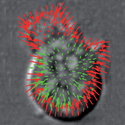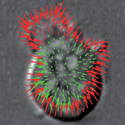Cells push, cells pull
One of the major problems in biophysics is the mechanics of how cells interact with their physical environment. Processes such as cell adhesion and migration depend in a crucial manner on physical forces exerted by (and on) cells.
In their paper in Physical Review Letters, Hélène Delanoë-Ayari and colleagues at the Université de Lyon, France, and co-workers at the University of Tokyo, Japan, study the motion of cells on a substrate with a new twist to earlier approaches. Typical traction force microscopy techniques have mainly been restricted to measurements of forces exerted by cells on substrates that act in the plane of the substrate⎯ , and (i.e., a “3D” force map emerges when one incorporates the time component). The authors study amoeba cells on a soft gel substrate where vertical deformation turns out to be critical; the vertical forces are measurable and comparable in magnitude to the in-plane counterparts. Incorporating this additional component enables the authors to develop a “4D” force map comprising upward pulling forces near the rim of the cell and downward pushing forces under the cell. Apart from the advance in microscopy techniques alone, an appealing universal picture of cell deformation emerges that is analogous to that of a liquid drop on an elastic substrate, where surface tension acts at the edges and the pressure of the fluid equilibrates these forces at the center. – Sami Mitra





